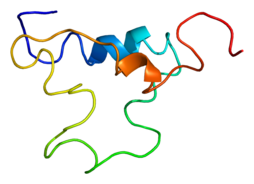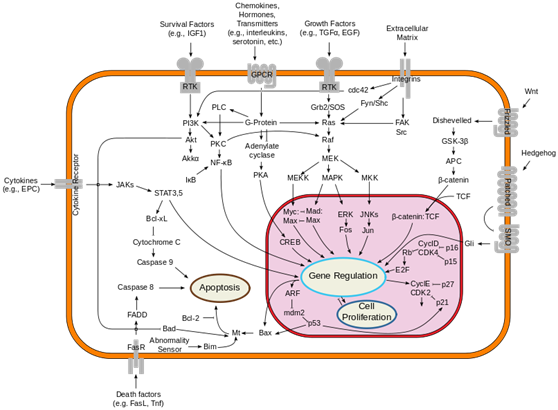Cyclic peptides (or cyclic proteins) are polypeptide chains where in the amino termini and carboxyl termini, amino termini and side chain, carboxyl termini and side chain, or side chain and side chain are linked with a covalent bond that generates the ring. A number of cyclic peptides have been discovered in nature and a plethora have been synthesized in the laboratory. Their length ranges from just two amino acid residues to hundreds. These cyclic peptides have several applications in medicine and biology.
Cyclic peptides can be classified according to the types of bonds that comprise the ring.
Homodetic cyclic peptides, such as cyclosporine A, are those in which the ring is composed exclusively of normal peptide bonds (i.e. between the alpha carboxyl of one residue to the alpha amine of another). The smallest such species are 2,5-diketopiperazines, being derived from the cyclisaation of a dipeptide.
Cyclic isopeptides contain at least one non-alpha amide linkage, such as a linkage between the side chain of one residue to the alpha carboxyl group of another residue, as in microcystin and bacitracin.
Cyclic depsipeptides, such as aureobasidin A and HUN-7293, have at least one lactone (ester) linkage in place of one of the amides. Some cyclic depsipeptides are cyclized between the C-terminal carboxyl and the side chain of a Thr or Ser residue in the chain, such as kahalalide F, theonellapeptolide, and didemnin B.
Bicyclic peptides such as the amatoxins amanitin and phalloidin contain a bridging group, generally between two of the side chains. In the amatoxins, this bridge is formed as a thioether between the Trp and Cys residues. Other bicyclic peptides include echinomycin, triostin A, and Celogentin C. There are a number of cyclic peptide hormones which are cyclized through a disulfide bond between two cysteines, as in somatostatin and oxytocin.
One interesting property of cyclic peptides is that they tend to be extremely resistant to the process of digestion, enabling them to survive in the human digestive tract.[1] This trait makes cyclic peptides attractive to designers of protein-based drugs that may be used as scaffolds which, in theory, could be engineered to incorporate any arbitrary protein domain of medicinal value, in order to allow those components to be delivered orally. This is especially important for delivery of other proteins that would be destroyed without such implementation. Cyclic peptides are also “rigid” compared to the corresponding linear peptides, and this attribute promotes binding by removing the “entropic penalty”. For example, Daptomycin is a lipopeptide antibiotic used in the treatment of systemic and life-threatening infections caused by Gram-positive organisms. It is a naturally occurring compound found in the soil saprotroph Streptomyces roseosporus. Its distinct mechanism of action makes it useful in treating infections caused by multiple drug-resistant bacteria. It is marketed in the United States under the trade name Cubicin by Cubist Pharmaceuticals [2].
Karebay can synthetic cyclic peptide with Cyanine or other fluorescent moleculars , so that scientists can knew more details about its molecular mechanism.
Karebay (www.karebaybio.com) has a professional team devoted to peptide products synthesis and development. We offer high-quality biotechnology products for sale around the world, including over 1,000 catalog peptides, and nearly 100 pharmaceutical peptides and cosmetic peptides products.
Reference
[1] David J. Craik (17 March 2006). “Seamless Proteins Tie Up Their Loose Ends”. Science 311 (5767): 1563–7. [2] Giuliani A, Pirri G, Nicoletto S (2007). “Antimicrobial peptides: an overview of a promising class of therapeutics”. Cent. Eur. J. Biol. 2 (1): 1–33.






